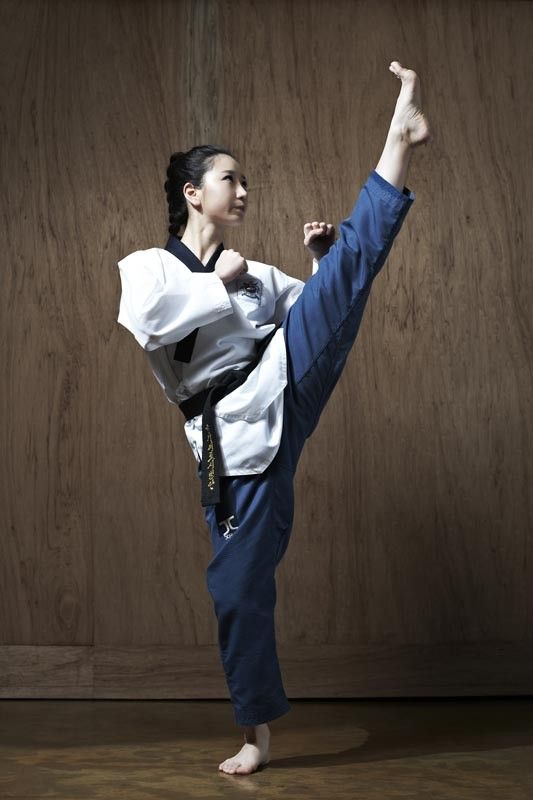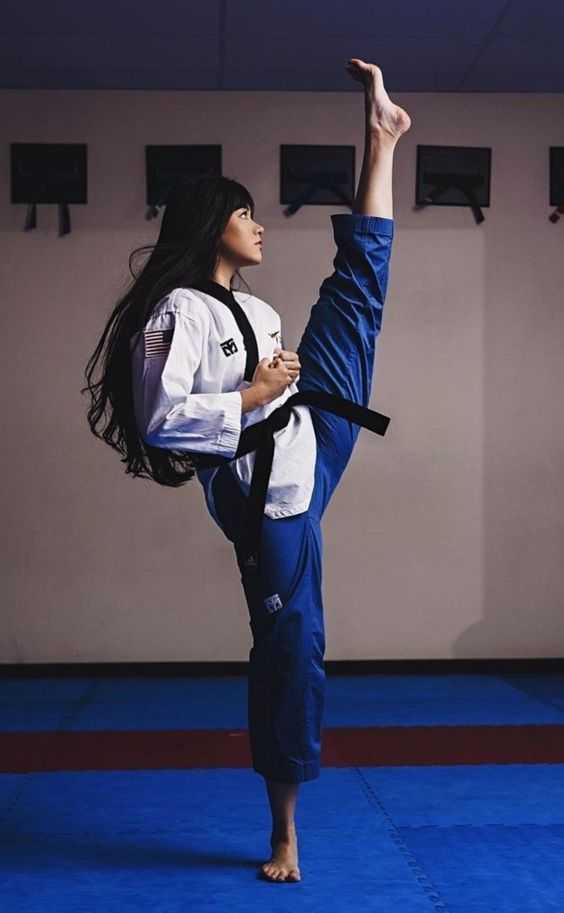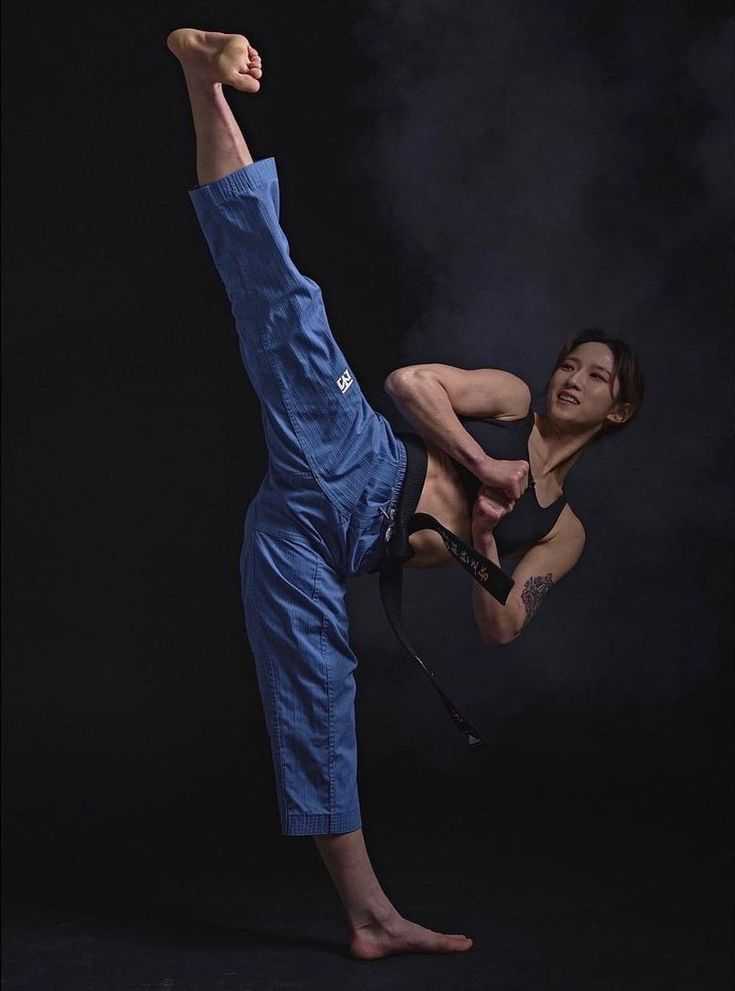Taekwondo, Tae Kwon Do or Taekwon-Do (/ˌtaɪkwɒnˈdoʊ, ˌtaɪˈkwɒndoʊ/; Korean: 태권도/跆拳道) is a Korean form of martial arts involving punching and kicking techniques, with emphasis on head-height kicks, spinning jump kicks, and fast kicking techniques. The literal translation for tae kwon do is “kicking”, “punching”, and “the art or way of”. They are a kind of martial arts in which one attacks or defends with hands and feet anytime or anywhere, with occasional use of weapons. The physical training undertaken in Taekwondo is purposeful and fosters strength of mind through mental armament.

The word “Tae“ “Kwon“ “Do“ is composed of three parts as shown in the English spelling, though it is one word in Korean. “Tae” means “foot,” “leg,” or “to step on”; “Kwon” means “fist,” or “fight”; and “Do” means the “way” or “discipline.” If we put these three parts together, we can see two important concepts behind “Tae Kwon Do”.
- First, Taekwondo is the right way of using Tae and Kwon ‘fists and feet,’ or all the parts of the body that are represented by fists and feet.
- Second, it is a way to control or calm down fights and keep the peace.
This concept comes from the meaning of Tae Kwon ‘to put fists under control’ [or ‘to step on fists’]. Thus Taekwondo means “the right way of using all parts of the body to stop fights and help to build a better and more peaceful world.”
Taekwondo practitioners wear a uniform, known as a dobok. It is a combat sport and was developed during the 1940s and 1950s by Korean martial artists with experience in martial arts such as karate, Chinese martial arts, and indigenous Korean martial arts traditions such as Taekkyon, Subak, and Gwonbeop.

The oldest governing body for Taekwondo is the Korea Taekwondo Association (KTA), formed in 1959 through a collaborative effort by representatives from the nine original kwans, or martial arts schools, in Korea. The main international organisational bodies for Taekwondo today are the International Taekwon-Do Federation (ITF), founded by Choi Hong-hi in 1966, and the partnership of the Kukkiwon and World Taekwondo (WT, formerly World Taekwondo Federation or WTF), founded in 1972 and 1973 respectively by the Korea Taekwondo Association. Gyeorugi (/kjʌɾuɡi/), a type of full-contact sparring, has been an Olympic event since 2000. In 2018, the South Korean government officially designated Taekwondo as Korea’s national martial art.
Taekwondo can be characterized by unity: the unity of body, mind, and life, and the unity of the pose [“poomsae“] and confrontation, and cracking down. When you do Taekwondo, you should make your mind peaceful and synchronize your mind with your movements, and extend this harmony to your life and society. This is how in Taekwondo the principle of physical movements, the principle of mind training, and the principle of life become one and the same. On the other hand, the right poomsae lead to the right confrontation, which will eventually produce great destructive power.

In taekwondo, taegeuk is a set of Pumsae (also known as Poomsae or Poomse), or defined pattern of defense-and-attack forms used to teach taekwondo.
Between 1967 and 1971, Kukkiwon-style taekwondo made use of an older set of forms called the palgwae forms developed by the Korea Taekwondo Association (KTA) with input from some of the original nine kwans of taekwondo. By 1970, additional kwans had joined the KTA so the newer set of taegeuk forms was developed to better represent inputs from all the participating kwans. By 1971, the palgwae forms were considered to be deprecated in favor of the newer taegeuk forms, though some schools still teach palgwae forms as well. All World Taekwondo Federation (WTF) Pumsae competitions use the taegeuk pumsae, along with 8 of the black belt Pumsae.
To gain a black belt, a student generally must know all eight Taegeuk Poomsae and also be able to perform all of them consecutively with no breaks in between.
Poomsae
| Name | Symbol | Techniques | |
|---|---|---|---|
| 8th Geup [yellow belt] | 태극 1장 (Taegeuk Il Jang) | ☰, “天”, “건”, “Heaven, Light” | Walking stance Front stance (also called long stance) Low block Inside block (also called middle block) High block Middle punch Front kick (also called front snap kick) |
| 7th Geup [yellow-green belt]) | 태극 2장 (Taegeuk Ee Jang) | ☱, “澤”, “태”, “Lake” | High punch |
| 6th Geup [green belt] | 태극 3장 (Taegeuk Sam Jang) | ☲, “火”, “이”, “Fire” | Back stance Knifehand middle block Knifehand neck strike |
| 5th Geup [green-blue belt] | 태극 4장 (Taegeuk Sa Jang) | ☳, “雷”, “진”, “Thunder” | Double knifehand block High knifehand block Palm block Back fist strike Spearhand strike Side kick |
| 4th Geup [blue belt] | 태극 5장 (Taegeuk Oh Jang) | ☴, “風”, “손”, “Wind” | Cross stance L-Shape Stance or right and left stance Outside block Hammer fist Elbow strike |
| 3th Geup [blue-red belt] | 태극 6장 (Taegeuk Yook Jang) | ☵, “水”, “감”, “Water” | Outer forearm block Double wedge block (also called opening block) Roundhouse kick |
| 2th Geup [red belt] | 태극 7장 (Taegeuk Chil Jang) | ☶, “山”, “간”, “Mountain” | Tiger stance Horse stance Lower knifehand block Double block Knee strike Double upset punch (i.e., uppercut) Crescent kick |
| 1th Geup [red-black belt] | 태극 8장 (Taegeuk Pal Jang) | ☷, “地”, “곤”, “Earth” | Mountain stance Jumping front snap kick |
역사
1945년 일제 해방을 전후해 국내에 여러 개의 무술 도장이 생기게 된다. 그 중 소위 ‘5대관’(청도관, 송무관, 무덕관, 지도관, 창무관)이 가장 유명하였는데, 이 도장들이 분화하여 생긴 9개관이 1960년대에 합쳐져서 현대 태권도의 모체가 된다.

특히 영향력이 강했던 도장은 청도관과 무덕관으로, 최초의 태권도장인 청도관은 이원국에 의해 설립됐는데, 그는 어렸을 때 서울 안국동에서 택견을 수련했고, 이후 일본으로 유학을 가 대학을 다니면서 근대 가라테의 아버지 후나코시 기친에게 송도관 가라테를 배웠다. 본인은 오키나와 무술로도 생각한듯. 중국에서는 쿵푸를 수련했다는 말도 있다. 다만 도장의 수련 스타일은 가라테 도장이었다. 이후 이원국은 본인을 한국 태권도 창시주로 지칭하기도 했다.
당시 최대의 태권도장이던 무덕관(1953년과 1970년 사이에 전체 태권도 수련자의 약 75%가 무덕관에서 배웠다) 은 황기에 의해서 설립됐는데, 그는 어릴 때 택견을 배우고, 중국에서 태극권과 쿵푸를 배웠다. (다만 자료 부족으로 그의 경력이 의심받기도 한다. 그리고 장단출신인 황기가 서울 무술인 택견을 실제로 알고있는지도 의문이며 나중가서는 택견은 형이 없어 무술도 아니라는식으로 비판한적이 있다.) 가라테는 직접 배운 적은 없고 책을 읽은 적은 있다. 황기는 전통무예에 관심이 많아 당수도로 시작했던 도장 명칭을 이후 화수도, 수박도 등으로 바꾸고 본인 주장대로라면 전통무예 수박에 영감을 얻어 본인의 창작무술 수박도를 창안하기도 하나, 태권도 통합 과정에 가장 소극적인 편이라 제자들과도 불화를 겪다 결국 무덕관에서 제명당하고 만다.

한국 주요 단체
ITF
국제 태권도 연맹 (ITF, The International Taekwon-do Federation)은 최홍희가 1966년에 9개국(미국, 일본, 아르헨티나 등)의 승인을 받아서 서울에서 발족했다. 라이트 콘택트제의 룰이지만, 한국만의 독자적인 무술을 만들기 위해서 3600개의 새로운 기술의 형태와 총 16권의 태권도 백과사전이 만들어졌다. 틀(WTF의 품새에 해당)에는 한국의 역사나 신화의 인물에서 따온 천지(天地), 중근(重根), 세종(世宗), 통일(統一) 등의 이름을 사용하고 있다. 특이점으로 태권도 창시자를 최홍희로 규정하고 있다. 1972년, 설립자인 최홍희가 박정희 정권과의 정치적 대립으로 캐나다로 이주하면서 본부가 캐나다로 옮겨가게 된다. 이후 말레이시아를 시작으로 북미, 남미, 서유럽, 오세아니아 그리고 조선민주주의인민공화국과 러시아, 중화인민공화국을 포함한 여러 공산국가에도 태권도를 보급하였다.
WT
세계 태권도 연맹 (WT, The World Taekwondo)는 최홍희가 1972년 망명한 이후, 남한에서 1973년 설립되었다. 현재 올림픽의 정식 경기가 되고 있는 것은 이 단체에서 주관한다. 머리와 몸통을 보호하는 보호구를 착용하도록 하는 등 스포츠에 적합화하여, ITF 태권도와의 차별화를 염두에 두고 있다. WT의 품새에는 고려(高麗), 금강(金剛) 등의 명칭이 쓰인다. WT는 ITF와 달리 태권도의 기원을 멀리 잡아 “가깝게는 택견으로, 멀게는 삼국시대의 화랑도와 수박까지 거슬러 올라갈 수 있다.”고 주장한다. 다만 이에 대해선 이견이 존재한다. World Taekwondo Federation (WTF) 이라는 이름으로 시작하였으나, 영어 약자가 내포할 수 있는 부정적인 뜻을 원천차단하고자 2017년 World Taekwondo (WT) 로 이름을 바꾸었다.
KTA
세계 태권도 연맹 (WTF) 의 한국지부인 대한 태권도 협회 (KTA, The Korea Taekwondo Association)는 1960년에 설립된 대한태권도협회를 기원으로 한다. 1965년 대한태권도협회로 개칭되었다. 2004년 10월 28일 대한민국 문화체육관광부 소관의 사단법인으로 설립허가 되었다.